Religion Nouveau
Flower Communion Sunday
Unitarian Universalist Congregation of Columbia
March 25, 2018
Rev. Jeff Liebmann
Call to Worship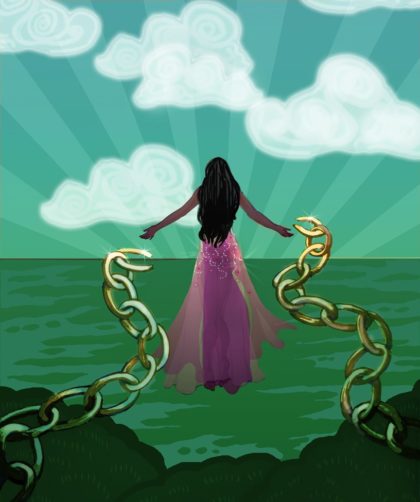
by Norbert Ĉapek
How can a person be ready to undergo difficult trials? He must ask himself: “What is mine and what is not mine?” Suppose I am to be imprisoned; must I also then lament and be discouraged? Suppose I am to be exiled; is there anyone able to prevent my going peacefully with a smile, good humor, and my head held high?
“We will put you in chains!” Ah, dear friends, the chains you mean to put upon my legs may restrain me but no chains can restrain my will or my spirit.…no force on earth can make it do what it doesn’t want to do.
Time for All Ages
A Minister’s Duty
Once upon a time in a far away country, there was a minister who served a very large church. The members loved their church, but they were very worried about their country because war was coming.
Now, this minister was very opposed to war. People in other countries warned him that he might not be safe if his country lost the war. He appreciated their concern, but he chose to stay with his church.
Well, the war came and his country was conquered by the invading army. Many people lost their homes and things were bad for everyone. Not only did the minister stay with his church, but he preached a series of sermons on freedom and justice. As you might imagine, the enemy soldiers did not like his sermons. They sent spies into the church and listened to everything he said.
But, the minister was very smart. He carefully chose his words so that he made the enemy soldiers angry, but not angry enough to hurt him. Their police even questioned him, but he was not arrested.
Time passed and things got even worse. The enemy began hurting the people more and more. They particularly hurt certain people who didn’t believe in God the same way they did. The minister continued preaching peace and justice for all people.
Suddenly, one night, the police burst into the minister’s home and arrested him. He was brought before a judge and his sermons were used as evidence against him that he was a threat to the enemy forces. He was found guilty and sent to prison.
This was a very sad time for the minister, who worried about what might happen to him. But, in spite of his fears, he continued writing hymns. He worked with other prisoners and ministered them through their fears. No matter what happened, he remained in good spirits and encouraged everyone around him to keep up their hopes.
Soon, the war was over, and the invading army was forced to leave the country. Now freed, many of the prisoners said that they would not have survived had it not been for the minister. Even though they were in jail, mistreated, and feeling hopeless, the minister kept them going with this message.
Clear your heart and mind of pain, anger, and things you can’t control. When you do this, no one can force you to do anything you do not want to do. No matter how bad the situation, you will be free as the wind.
Reflection
from “Color and Its Kinship to Sound,” by Louis C. Tiffany
 …Light is composed of vibrations of differing wavelengths, each vibration giving a different color…Today we are beginning to realize that these light-vibrations have a subjective power and affect the mind and soul, producing feelings and ideas of their own in the recipient brain…
…Light is composed of vibrations of differing wavelengths, each vibration giving a different color…Today we are beginning to realize that these light-vibrations have a subjective power and affect the mind and soul, producing feelings and ideas of their own in the recipient brain…
We are all at work toward the same ideal, which is – Beauty. That same Beauty is what Nature has lavished upon us as a Supreme Gift – it is all about us to see and use. Copying what others have done helps us indeed to exercise our eyes; but merely to copy and not to employ our imagination – is to strangle our talent, our heritage! Styles are merely the copying of what others have done, perhaps done better than we. God has given us our talents, not to copy the talents of others, but rather to use our brains and imagination in order to obtain the revelation of True Beauty!
Sermon – Religion Nouveau
Historians view social change in various ways, from models resembling the lumbering motion of tectonic plates, to a Darwinian theory of endless mutations. I favor an approach to history focusing on the oftentimes massive impact of simple acts of people who, in any other parallel universe, lived unspectacular lives of modest influence.
Moments that bring together two or more such people at a certain time and place are especially noteworthy. One such instance began with a chain of events starting in the late 1830’s. Antoine Léandre Sardou owned an estate of olive trees in Southern France. One night, a frost killed the trees and ruined him financially. Sardou moved his family to Paris, where he scrabbled out a living as a bookkeeper, teacher, and editor.
Once Sardou’s son was old enough to fend for himself, Antoine retired back to the country. Left to his own resources, Victorien Sardou began studying medicine, but dropped out due to lack of funds. He taught French to foreign pupils, gave students lessons in Latin, history, and mathematics, and wrote articles for cheap encyclopedias.
The young man struggled to write for the theatre and sought the sponsorship of Parisian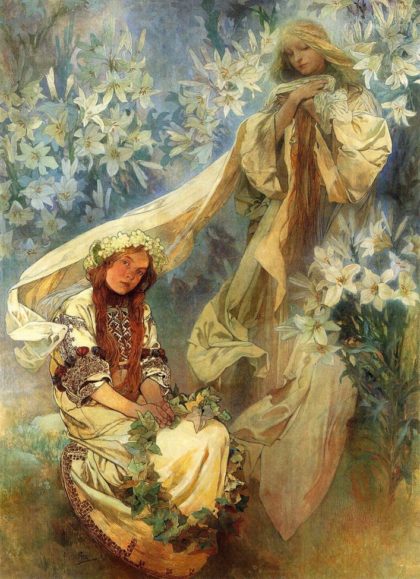 women of means. He saw one of his plays produced, but met with unfavorable reviews. Then Victorien contracted typhoid fever at age 26 and lay dying among his rejected manuscripts.
women of means. He saw one of his plays produced, but met with unfavorable reviews. Then Victorien contracted typhoid fever at age 26 and lay dying among his rejected manuscripts.
Unexpectedly, a neighbor woman nursed and cured him and became his first wife. She happened to have connections in the theatre. In the coming years, Victorien’s life turned the corner, setting the stage for his most famous collaboration.
Movies have made household names out of Bette Davis, Katherine Hepburn, Elizabeth Taylor, and Meryl Streep. They all owe their careers to the greatest actress of the 19th century stage, Sarah Bernhardt. In the 1860’s and 70’s, Bernhardt lived the life now common among celebrities. Bernhardt travelled the stages of Europe, had a child with a Belgian nobleman (whose family denied them approval to marry), and courted famous actors, artists, writers, and scientists. She had a scandalous relationship with a woman and an alleged affair with a future king of England.
In 1882, Victorien Sardou wrote Fédora, the first of many plays specifically with Bernhardt in 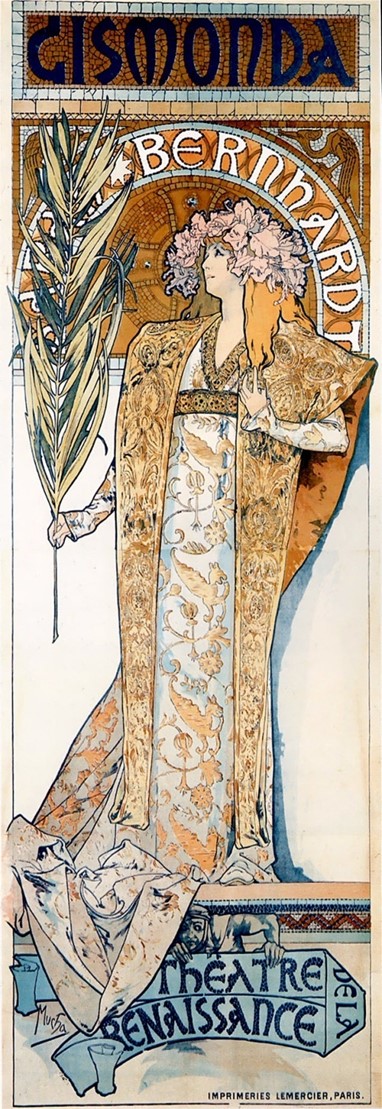 mind. These were followed by Thédora (1884), La Tosca (1887), and Cléopâtre (1890). It was not until 1894, however, that our story continues. Sardou and Bernhardt united once again for Gismonda, a melodrama about a Greek widow serving as regent for her five-year-old son, the Duke of Athens.
mind. These were followed by Thédora (1884), La Tosca (1887), and Cléopâtre (1890). It was not until 1894, however, that our story continues. Sardou and Bernhardt united once again for Gismonda, a melodrama about a Greek widow serving as regent for her five-year-old son, the Duke of Athens.
The afternoon of Christmas Eve, 1894 found Bernhardt on the telephone with the Lemercier printing works expressing her dissatisfaction with the poster promoting her new production. Alphonse Mucha, an obscure, largely self-taught artist from Moravia, sat nearby correcting proofs for a friend. Desperate for an available artist during the holidays, Mucha was offered the job to produce a new poster.
Mucha accepted the commission and quickly produced a poster released on January 1, 1895. The poster elicited massive public and critical attention for its new style and moved Bernhardt to sign a six-year contract with Mucha, now catapulted into immediate fame.
Mucha’s distinct style quickly influenced architects, interior designers, and decorative artists of jewelry, furniture, textiles, household utensils, and lighting. Labeled art nouveau, or “new art,” the movement swept Europe and spread quickly across the globe. In part a reaction to the classical art being taught in formal academies at the time, art nouveau was characterized by organic motifs, particularly flowing floral and plant lines and curves.
Mucha rode a wave of international acclaim for the next two decades. He spent many years in the United States, teaching and maintaining a vigorous output of graphic works. After the conclusion of World War I and the creation of an independent Czechoslovakia in 1919, Mucha returned to his homeland.
There, at the same time Norbert Ĉapek was building his Unitarian Fellowship, Mucha devoted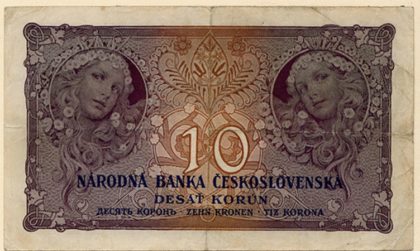 his time and talents to the new nation, designing postage stamps, currency, and a wide variety of government documents. In 1928, he bestowed The Slav Epic, a series of 20 huge paintings depicting the history of the Czechs and the Slavic people in general to the city of Prague.
his time and talents to the new nation, designing postage stamps, currency, and a wide variety of government documents. In 1928, he bestowed The Slav Epic, a series of 20 huge paintings depicting the history of the Czechs and the Slavic people in general to the city of Prague.
The rising tide of fascism during the late 1930’s resulted in the press condemning Mucha’s works, largely influenced by his Slavic nationalism, as reactionary. When German troops moved into Czechoslovakia during the spring of 1939, Mucha was among the first arrested by the Gestapo. During his interrogation, the aging artist became ill with pneumonia. Though released eventually, he was weakened by this event and died in Prague on July 14, 1939 of a lung infection.
So, our story of a frost killing olive trees near Cannes almost two centuries ago comes full circle, concluding in a similar way as the story of Norbert Ĉapek. Two men, both enormously influenced by the natural beauty of their homeland, their lives tragically ended. Two men, whose lives were dedicated to the promotion of spiritual growth through the artistry of flowers, killed by a modernist regime gone mad. Two men, one who created a celebration of flowers, and the other whose work continues to inspire reverence.
The dominance of the art nouveau movement lasted only a short time. But, the influence of 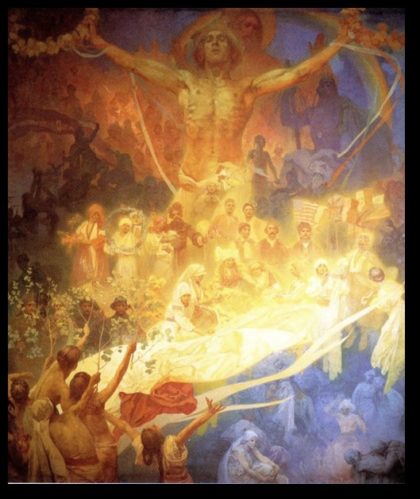 new art changed the way we imagined and designed our living spaces. Art nouveau reconnected humanity and its artistic imagination with the surrounding world. This new approach simply reminded us that the best way of being is perhaps the oldest way of being – to see beauty in the colors and shapes of our natural world, to live in harmony with its forms, and to sustain its life through our own living.
new art changed the way we imagined and designed our living spaces. Art nouveau reconnected humanity and its artistic imagination with the surrounding world. This new approach simply reminded us that the best way of being is perhaps the oldest way of being – to see beauty in the colors and shapes of our natural world, to live in harmony with its forms, and to sustain its life through our own living.
Nearly two decades into a new millennium, perhaps we need a reminder from this past. At a time when our activity in religious communities continues to decline, perhaps we need to remember why religions exist in the first place. At a time when morality is used like a weapon to promote hate and violence, perhaps we need to remember the interconnectedness of our environment and the need for all life forms to rely on each other for survival. At a time when people seek happiness through power and greed, perhaps we need to remember the simple joy of a flower – it’s fragrance, its delicacy, its vivid display in the summer sunlight.
Like the stodgy and stale art of the late 19th century, our churches today need a new approach, a nouveau religion. Like the flower, whose nectar sustains the insects that in turn germinate its seeds, we must focus again on the primary purpose of religion. The new religion should preach the interdependent web of all existence. The new religion should preach unconditional love among all people, for our world, and of the wonder and beauty of our universe. The new religion should celebrate our human gifts of courage and reason as we seek answers to eternal questions, comfort each other in times of hardship, and work to build a just world for everyone.
So, how do we go about creating this nouveau religion? Well, perhaps it already exists, but we have not extended its influence into every aspect of our lives. Alphonse Mucha was a graphic artist who designed posters and murals, magazines and post cards, calendars and menus, stamps and bank notes. Art nouveau influenced Louis Tiffany to make amazing lamps, René Lalique to craft fantastic jewelry, and Antonio Gaudí to design one of the most remarkable cathedrals in the world.
Maybe nouveau religion must reach out outside sanctuary walls, beyond Sunday mornings, and into virtual realms of social networking. As the devotees of nouveau religion, we should be on the streets working for equality and justice; we should be living our beliefs every day through our words and actions; and we should employ every medium to express our principles to the world. As Unitarian Universalists in the 21st century, we should never stop rebelling against the tyranny of tradition and the complacency of comfort.
In the end, the answers are as simple and as complex as a flower.
Consecration of the Flowers
From Ĉapek’s original 1923 Blessing of the Flowers
Following World War I and the creation of an independent Czechoslovakia, Norbert Ĉapek founded a Unitarian congregation in Prague called the Liberal Religious Fellowship. He introduced the Flower Festival service on June 4, 1923 as a ritual to unite people in the new congregation. Many members found the Christian communion service unacceptable after leaving the Catholic church. So Ĉapek used the native beauty of the land to create a unique celebration.
He asked people to bring flowers to church and place them in large vases at the entrance. During the worship service, Ĉapek consecrated the collected flowers. Afterwards, people returned to the vases and took a different flower home with them. It was such a success that it was held yearly just before the summer recess of the church. His fellowship grew into the largest Unitarian congregation in the world, with a membership of almost 3,400 by 1932.
The Flower Communion represents a holy ritual unique to Unitarian Universalism. Like similar events in other faith traditions, the Flower Communion functions on many levels. We remember the martyrdom of Norbert Capek, as well as others who sacrificed and died for the cause of liberal religion over the years. We celebrate life, through its most colorful and fragrant representatives – flowers. We come together, in body through worship and in spirit through the gifts we have brought to share with others. And by them all, we experience the divine, through our history, our unity with nature, and the mingling of our thoughts and deeds. We take a flower home with us, a tangible symbol of the power of this religious community in our lives.
Minister: In the name of Providence, which implants in the heart of the seed the future of the flower, and which implants in our hearts that unrest which will not be quenched until people live lovingly with each other, we bless these flowers.
Congregation: In the name of the Highest, in which we move and take our being, and in the name of the Deepest, which makes father and mother, sister and brother, lover and loner who they are, we bless these flowers.
Minister: In the name of the prophets and sages who sacrificed their lives to hasten the coming of the reign of mutual respect, we bless these flowers.
Congregation: Let us renew our resolution, sincerely, to be brothers and sisters regardless of the barriers which estrange.
Minister: May these flowers be for us the sign of the glory and variety to which we aspire, knowing the whole while that we are One Family, the Family of Spirit and Nature.
All: In this holy resolve, may we be strengthened by the spirit of love, that we ourselves may bloom, bloom in splendor of a joyful life, and endeavor to be ever more perfect in our days.
Prayerful Reflection
Spirit of life and love that we know by many names, be with us as we enter an attitude of reflection, meditation, and prayer.
Honoring innovators of the past will not suffice to maintain our survival in the future. For we best honor the creators of history by ourselves changing the course of history – by ourselves becoming the new change agents.
This call demands great courage. It requires that we step into unknown lands and face unknown dangers. It also compels us to stand firm against detractors and those who would chain us to old ways for their own gain.
May we draw inspiration from the flowers, who are reborn again and again, yet stay true to their founding character. And may our courageous ancestors fertilize the ground from which we will spring to face a new dawn.
Let it be so.
Closing Words
By Norbert Ĉapek
Norbert Ĉapek wrote these words just before his death:
It is worthwhile to live and fight courageously for sacred ideals. Oh, blow, you evil winds, into my body’s fire. My soul, you’ll never unravel. Even though disappointed a thousand times or fallen in the fight, and everything worthless seem, I have lived amidst eternity. Be grateful, my soul. My life was worth living. The one who was pressed from all sides but remained victorious in spirit is welcomed into the choir of heroes.
Anyone interested in learning more should read the outstanding biography, Norbert Fabiàn Ĉapek: A Spiritual Journey, by Richard Henry (Skinner House Press, 1999)

